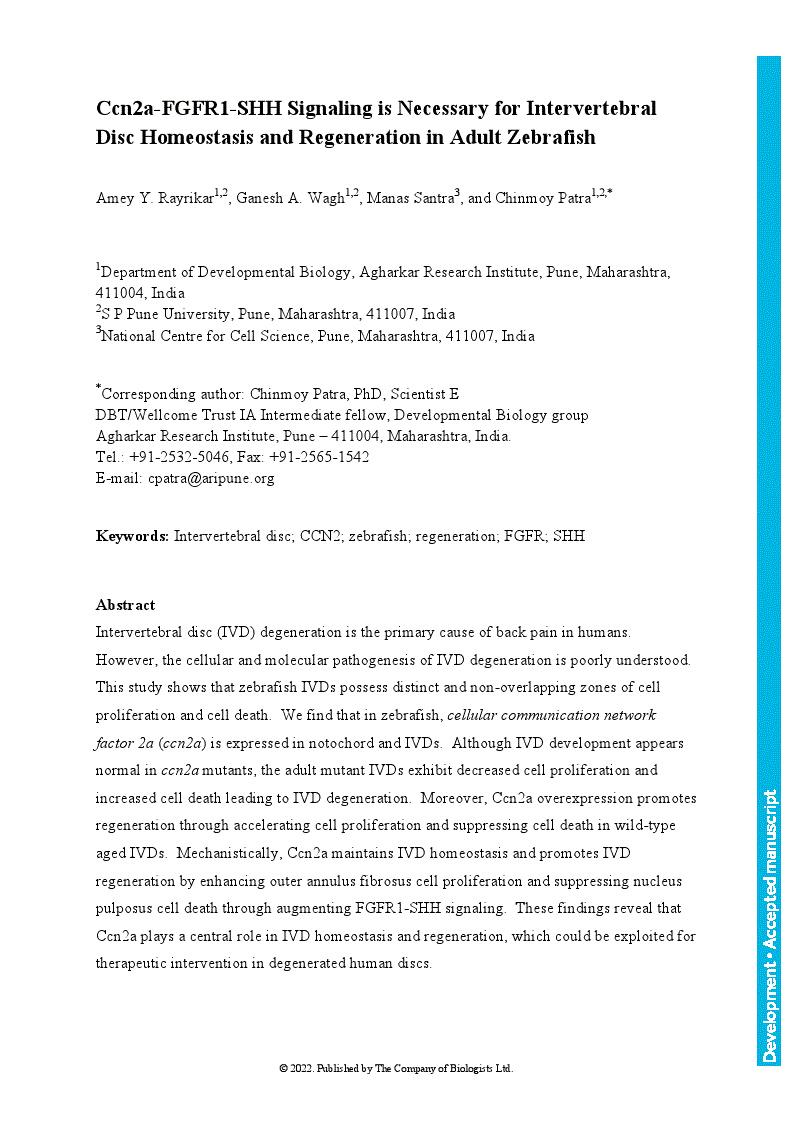Intervertebral disc (IVD) degeneration is the primary cause of back pain in humans. However, the cellular and molecular pathogenesis of IVD degeneration is poorly understood. This study shows that zebrafish IVDs possess distinct and non-overlapping zones of cell proliferation and cell death. We find that in zebrafish, cellular communication network factor 2a (ccn2a) is expressed in notochord and IVDs. Although IVD development appears normal in ccn2a mutants, the adult mutant IVDs exhibit decreased cell proliferation and increased cell death leading to IVD degeneration. Moreover, Ccn2a overexpression promotes regeneration through accelerating cell proliferation and suppressing cell death in wild-type aged IVDs. Mechanistically, Ccn2a maintains IVD homeostasis and promotes IVD regeneration by enhancing outer annulus fibrosus cell proliferation and suppressing nucleus pulposus cell death through augmenting FGFR1-SHH signaling. These findings reveal that Ccn2a plays a central role in IVD homeostasis and regeneration, which could be exploited for therapeutic intervention in degenerated human discs.
Ccn2a-FGFR1-SHH signaling is necessary for intervertebral disc homeostasis and regeneration in adult zebrafish
- Award Group:
- Funder(s): The Wellcome Trust DBT India Alliance
- Award Id(s): IA/I/18/2/504016
- Funder(s):
Currently Viewing Accepted Manuscript - Newer Version Available
- Split-screen
- Views Icon Views
- Open the PDF for in another window
-
Article Versions Icon
Versions
- Version of Record 06 January 2023
- Accepted Manuscript 02 December 2022
- Share Icon Share
-
Tools Icon
Tools
- Search Site
Amey Y. Rayrikar, Ganesh A. Wagh, Manas Santra, Chinmoy Patra; Ccn2a-FGFR1-SHH signaling is necessary for intervertebral disc homeostasis and regeneration in adult zebrafish. Development 2022; dev.201036. doi: https://doi.org/10.1242/dev.201036
Download citation file:
Advertisement
Call for papers: Uncovering Developmental Diversity

Development invites you to submit your latest research to our upcoming special issue: Uncovering Developmental Diversity. This issue will be coordinated by our academic Editor Cassandra Extavour (Harvard University, USA) alongside two Guest Editors: Liam Dolan (Gregor Mendel Institute of Molecular Plant Biology, Austria) and Karen Sears (University of California Los Angeles, USA).
Choose Development in 2024

In this Editorial, Development Editor-in-Chief James Briscoe and Executive Editor Katherine Brown explain how you support your community by publishing in Development and how the journal champions serious science, community connections and progressive publishing.
Journal Meeting: From Stem Cells to Human Development

Register now for the 2024 Development Journal Meeting From Stem Cells to Human Development. Early-bird registration deadline: 3 May. Abstract submission deadline: 21 June.
Pluripotency of a founding field: rebranding developmental biology

This collaborative Perspective, the result of a workshop held in 2023, proposes a set of community actions to increase the visibility of the developmental biology field. The authors make recommendations for new funding streams, frameworks for collaborations and mechanisms by which members of the community can promote themselves and their research.
Read & Publish Open Access publishing: what authors say

We have had great feedback from authors who have benefitted from our Read & Publish agreement with their institution and have been able to publish Open Access with us without paying an APC. Read what they had to say.



